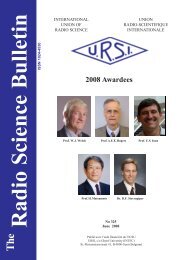Radio Science Bulletin 313 - June 2005 - URSI
Radio Science Bulletin 313 - June 2005 - URSI
Radio Science Bulletin 313 - June 2005 - URSI
- No tags were found...
You also want an ePaper? Increase the reach of your titles
YUMPU automatically turns print PDFs into web optimized ePapers that Google loves.
Bandwidth f l / f c f h / f c B F Classification E relB 3dB 1.04 2.96 0.96 UWB / SHB 97.21 %B 10dB 0.97 3.02 1.03 UWB / SHB 99.16 %B 20dB 0.83 3.14 1.16 UWB / SHB 99.83 %B RMS 0.18 3.82 1.82 UWB / HB 99.91 %B 90EB 1.06 2.84 0.92 UWB / SHB 90 %1.16 2.94 0.87 UWB / SHB 90 %B 99EB 0.98 3.02 1.01 UWB / SHB 99%Table 6. Classification of the LFM waveform with n = 800 and µ = 0.01 f cfor six bandwidth definitions.6. Challenging QuestionsAlthough the four test signals evaluated in this paperare considered well behaved, they pose challenging problemsfor the articulated bandwidth definitions and classificationschemes. For example, two very different signals can beclassified as hyperband (UWB): (1) an impulse-like 10 psGaussian signal with a bandwidth, B, in the tens of GHz anda lower frequency of 0 Hz (set t p = 10 ps in Table 4); and(2) an extremely long duration pulse with a nearly flatmagnitude spectrum and B on the order of a few Hz (a linearfrequency-modulated signal with a very large number, n, ofhalf cycles and a very low chirp rate, µ ). That these twoextremes would belong to the same category perhapssuggests the need for a general classification scheme withmore than one parameter to distinguish signal types, if ascheme is to be applicable for arbitrary signals andapplications. Typically, UWB has been associated withshort-pulse signals only: a large number of articles andstandardization publications discuss UWB only with regardto short-pulse signals. In contrast, the proposed UWBdefinition and classification scheme does not require thefrequency range to be completely occupied and,consequently, non-impulsive signals may be UWB.Many bandwidth definitions suffer from not beingwell defined for an arbitrary waveform. It is unclear whethera specific bandwidth definition exists for each waveform.In the case of a rectangular spectrum with a beginningfrequency f b and an ending frequency f e , the energybandwidth B 90EB is equal to 0.9( fe − fb), because anyinterval with a width of 0.9( fe − fb)contains 90% of thesignal energy. However, the power-level bandwidth BXdBis not defined for X > 0 , since no horizontal line intersectsthe power spectral density, except for X = 0 . AlthoughB 90EB is uniquely determined, the fractional bandwidthand the band ratio are not defined, because many f l inf , f 0.9ff − f = 0.9 f − f .[ + ] satisfy ( ) ( )b b eh l e bAnother problematic issue arises when signal spectrawith notches or multiple peaks cause trouble for the powerlevelbandwidth definitions, since the chosen power levelmay intersect the magnitude spectrum at more than twopoints. Even if the fractional energy bandwidth is uniquelydefined for this kind of signal spectrum, its interpretation isnot without problems. Specifically, a nonuniformdistribution of the notches and peaks can induce a nonuniformenergy distribution over the frequency band, andconsequently signals with identical energy-bandwidth valuescould significantly differ. For example, the notches of onesignal could match the peaks of a second signal, and visaversa. One means for addressing this issue would be tointroduce a parameter (peak-to-valley ratio) that describesthe ripple content or waviness of the magnitude spectrumwithin a specified band.Finally, a parameter that has been ignored by UWBdefinitions and classification schemes is the phase spectrum.This omission may be acceptable for the classification ofsignals, but phase plays an important role in describing andcharacterizing devices. In this vein, one might want toquantify the goodness of a UWB device by specifying howclosely the magnitude and phase of the device’s transferfunction approximate constant and linear functions,respectively. This goodness criterion is equivalent toquantifying how closely a device’s output matches its input.One possible means of quantifying this goodness is tocalculate the fidelity [15] between the input and outputsignals.Deeper discussions of these challenging questions,as well as treating less ideal signals like spectra with wideenergy spreads and medium strong peaks, are the subject offuture research.7. SummaryThis article has discussed the definition andclassification of UWB signals and devices in terms offrequency coverage and bandwidth. Three apparently similarUWB classification schemes have been compared, and thedifferences in how they define bandwidth and categorizationcriteria have been highlighted. After analyzing theThe<strong>Radio</strong> <strong>Science</strong> <strong>Bulletin</strong> No <strong>313</strong> (<strong>June</strong>, <strong>2005</strong>) 25
















